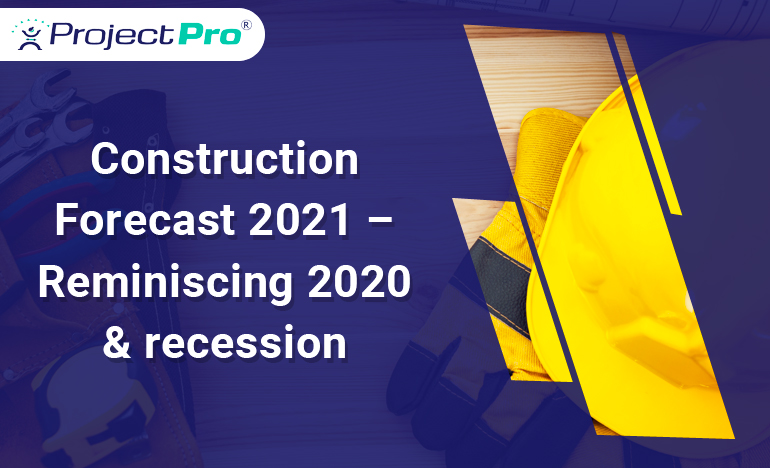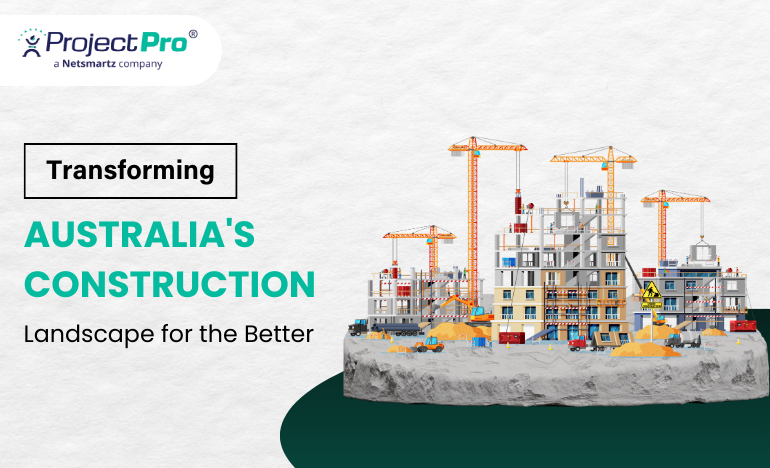Construction Forecast 2021: The ‘V-shaped’ Recovery and The Effect of Recession

Before we start with the idea of construction economic forecast in 2021, it is equally important to trace the marks of the industry from the previous year. This is because the entire detail of the past success and hurdles would serve as the ground for the future growth and industry performance in 2021.
Talking about January 2020, when the global pandemic started to strike the United States, the construction industry was in a pretty good position even though it had long hauled issues related to human capital. In January 2020 alone, the nation had around 214,000 net new jobs while the numbers continued to improve in February 2020 with massive 251,000 jobs.
Nevertheless, this was not a two-month story or something about 2020 only as the nation had extensive addition to the jobs driving a streak for job growth from 113 consecutive months. Surprisingly, the Unemployment in the United States rolled down to a 50 year low of 3.5 percent during the pandemic compared to the 10 percent that happened during the most turbulent times of the Great Recession i.e. December 2007 to June 2009. Post-June 2009, the United States has tremendous Wage growth that accelerated the economic life in the country while helping with retail sales, more home purchases, frequent construction, and more.
Even though the construction industry was performing well in terms of capital, jobs, and business opportunities, lack of skilled labor was a factor that was consistent amongst all contractors. But still, the American economy during the first quarter of 2020 looked to grow at an untiring pace.
Having no denial for the dipping of unemployment and rapid progress on the wages, the effect of inflation was very gentle before the spread of the global pandemic. The situation before January 2020 helped was all favorable to bring down the interest rates driving financial markets and create wealth for all improving scope for investments and expenditures, especially the building permits in case of construction.
All in all, the United States managed to sustain a whole decade without any financial downtime which made it more promising for the country to sustain any such situation in the future reminiscing the footprints from the past. Besides this, the global share of output improved from 23 percent at the beginning of the previous decade to 25 percent in 2020.
However, the last year of the previous decade surprisingly stuck by biological catastrophe causing recession-like circumstances that were not the result of the loss of demand but irresistible force damaging the supply. Adding to that, the impact was not only visible to the construction industry but even the symbols of essential American lifestyle such as restaurants, shopping malls, theaters, and manufacturing units.
The Second Quarter of 2020 – Beginning of the Downfall
Unlike the recession of 2007, the economic downfall that happened in 2020 was not gradual. Though the situation was quite predictable from late January, the behavioral change of the consumers started in February 2020 making situations even worse during March and April.
After the 2007 recession, the economic expansion in the United States was colossal creating more than 22 million jobs. However, the loss was identical in numbers as the United States entered the second quarter of 2020 as the unemployment surged to 14.7 percent during April 2020 while many economists claimed the actual peak to touch forever low of 20 percent.
This event had a significant impact on the stock market cutting down the aggressive corporate earnings with record-making stock repurchases, mergers-and-acquisitions that started in late 2017. Unfortunately, all the build-up fell down as Dow Jones Industrial Average of 29000 to 18,000 within days due to COVID-19.
On this downfall, the U.S. Bureau of Economic Analysis estimated that the national economy got 5 percent thin on an annualized basis during the first quarter even though February showed enough momentum for progress. Adding to the loss, March’s latter three weeks were even more awful in terms of loss.
During the second quarter, the Nation’s GDP started to decline for the worse as the number approached 31.4 percent downfall which was almost 4 times in comparison to 8.4 percent which was the maximum low that happened during the last quarter of 2008 hammering the budgets for households, companies, and even the government.
When the economic downturn was all expected to go worse with April turning to May and economists suggesting another loss of 8 million jobs, it felt like the passing of an enormously violent yet quickest storm ever.
Thanks to the reopening decisions made by the respective governors for their states that helped to create 2.7 million jobs in May and an even better figure in the month of June with 4.8 million jobs.
However, a big reason behind this sudden economic boost was the eCommerce giants such as Amazon that hired tens of thousands of people during the worst. Also, the idea of remote work helped the economy to float with the participation of fortune companies like DocuSign, Zoom, etc. Also, the traditional businesses such as local retailers, material suppliers, and restaurants all started to add to the economic revival depending on the Governor’s reopening orders and the number of daily infections.
This made many economists predict a soft recovery from the situation as they believed the initial momentum will be slow due to a consistent health crisis across the United States. But this time, the situation again turned in contradiction of the prophecy and sustained for the third quarter of 2020.
Though State Governors have their reasons behind their reopening goals, some were found to have an approach that aims at economic growth reducing the number of job losses. A similar case was seen with reopening policies of Florida, Georgia, and Texas in comparison to health-oriented policies shared by the Governors of New York, Hawaii, and Massachusetts. However, when it comes to the reality of construction, the construction activities started to spike in May with increased sales for homes, residential building permits, and manufacturing.
During the first and second quarter of 2020, most economists started to have debates on the shape of the recovery. Some considered it to be U-shaped while others were expecting it to be L-shaped, V-shaped, a parabolic curve, and whatnot. However, it all ended with maximum votes favoring the V-shaped recovery. However, things began to change as Congress leaders in the United States began to strengthen the economy by investing trillions of dollars to the stock market. Aside from this, the CARES Act, the official economic support program, launched by Federal Government on March 27, 2020, brought $2.2 trillion of financial aid to all businesses and households, stimulating the growth phase during the crisis.
Under this financial stimulus package, the Federal Government provided a $1200 check to some Americans while those who lost their jobs were eligible for a federal subsidy of $600/week on top of the benefits they were receiving from their state unemployment insurance. Before the COVID-19 hit the U.S. the average savings for a household were accounted to be 7 to 8 percent of the personal disposable income.
However, the figures took a massive jump to 33 percent by the month of April which further get a turbocharged boost as the U.S. started to move towards reopening. This influenced the V-shaped trajectory for the recovery, and it became quite profound by September.
September 2020 called for an extensive recovery of the jobs (almost half of the jobs that were lost during the first quarter). And the best part was the economic impact of the pandemic was not so severe unlike how it was predicted.
Rather many high waged workers who were working remotely agreed to preserve their employment while paying taxes. This even included the professionals from the construction industry as construction was deemed as an essential practice. Such support to the government helped preserve so many jobs and cut-off any additional backlog that would have made it more difficult to recover.
As long as June 2020 started, the retail sales started to grow and of course better than the pre-recession figures. The same pattern remained to continue till September 2020 giving a record monthly high of $493 billion which was $110 billion than what was recorded in April 2020. The best part was the unemployment which peaked to reach 14.7 percent fell to 8 percent during September 2020.
All these incidents gave a huge boost to residential construction and housing construction. One of the significant reasons behind this inclination was the aged couples who need to align with social distancing norms and were ready to take advantage of record-low mortgage rates on home office and housing leading to higher demand. This made the homebuilders gain their confidence and take advantage of the rising demand to skyrocket the prices for available and unsold property.
However, the situation called for a decline in rents even for the most expensive communities like Manhattan and San Francisco. The average rent amount declined below $3000 in Manhattan for the first time since 2011 as per the reports shared by StreetEasy. Besides this, the situation for home builders was equally lucky and stressful as the increased demand for housing also involved growing prices of softwood lumber. Overall, the growing demand and the supply chain disruptions called for trade wars in the middle of the residential construction boom.
The Beginning Of A New Reality
Even though timely decisions were made by the state governments favoring economic recovery, a growing number of cases was still a challenge for most Americans. The economic shutdown made during the first quarter was of huge help to flatten the curve for rising infections, but as the summer approached there was a parabolic rise in the infection tallies and number of people hospitalized.
Amidst all this hassle and such sharp recovery during the initial phase of recovery, all the policymakers in Washington quarreled about continuing the stimulus to keep up the effect of the CARES Act. However, such clashes and delay made to send stimulus to the people lead to much larger layoffs even for the big brands like American Airlines, United Airlines, Disney, and many more.
This situation signaled for the ‘V’ of recovery to turn into ‘W’ creating the scope for another recession. But the chances of the recession still looked prominent even if the stimulus is launched as it only looked to be supporting the demand side and not the production side. And this does not look like solving the issue of mass layoffs, lost consumer confidence, bankruptcies, and other pitfalls. This made the winter look bleaker, especially in the light of what was happening during the first, second, and third quarter of 2020.
The Downturn of Commercial Construction
Consider it the pandemic or the recession that emerged due to the sudden halt, the situation has turned quite unfavorable for any non-residential construction. Especially, when commercial construction is already struggling for over a decade, the added effect of pandemic pushed the existing projects to remote causing retailer bankruptcy and under-occupied hotels.
According to research made by economists at the University of Chicago, 37 percent of jobs could be done from home completely. Though the idea was quite well understood before the emergence of the pandemic, the only surprising factor was better productivity levels measured for the people working from home.
Since the office environment involved a large number of distractions such as conversations with other employees, staff meetings, and lengthy discussions, working at home was a better idea with minimal distractions and that too could be resisted and endure.
Though it may not sound good for office construction plans, most firms who have their office space build during the last decade have considered the importance of improving their offices to Class A or Class A+. And a few reasons for taking such actions included brand prestige, better recruitments, and of course most significantly the retention of skilled employees by giving them an appealing environment.
However, the circumstances looked very changed with growing unemployment. Also, the students graduating during 2020 or 2021 were not so positive about the position of markets when it comes to employment. Therefore, it becomes natural for many firms to opt for less luxurious space even in the suburbs. In the light of these facts, the total spending made to office construction dropped by 9 percent in August 2020 while for lodging it dropped to 12 percent due to reduced business travel and leisure.
This even had a huge impact on design work affecting architects and bringing the Architectural Billings Index to go below the threshold reading of 50 since March 2020. Based on the numbers, it was all predictable that architects have started to become less busy, the popular northeast markets of New York and Boston were losing jobs, while architects and contractors all were suffering through significant business loss.
Furthermore, the contractors even had to struggle while bidding due to fewer opportunities and greater competition. This even added more pressure on the contractor’s backlog data with increased chances of receding. Moreover, the traditional brick and mortar stores were also having trouble maintaining liquidity as popular names like Brooks Brothers, Nieman Marcus have already declared bankruptcy. This put a risk of closure in upcoming years on almost 300 malls around the nation (almost a quarter) while most communities started to forge plans that can help with underutilized retail space while working on existing and prospective overhangs.
Also, the reducing opportunities with commercial construction have affected the average work hours for the laborers despite the homebuilding opportunities. Adding to that, the winter recession has equally contributed to an increase in limited work hours in comparison to normal seasonal work hour availability.
If you think that is all that is happening, there is even more. The lending to commercial projects has reduced as the finances available with state and local government have shrunk. This has made many leading investors and real-estate pros avoid risk-taking. Besides this, the employment in non-residential or commercial construction has even dropped by 6 percent in comparison to last year.
However, the market still has some bright spots as the eCommerce trend is on the rise due to shutdowns and social distancing norms. Also, the backbone of these online retailers i.e. trucking, data centers, and fulfillment centers are likely to create a significant need for construction to keep up the pace of eCommerce.
In addition to this, there are chances that 2021 would be a year that will favor more of Class B office construction which will be done to meet the purpose and reduce the expenses. Therefore, it is a great time for all general contractors and subcontractors to position them good. Since most people are looking for better air handling systems, this would also be a great opportunity for HVAC contractors while other focus areas would include renovation or upgrades for restrooms, lobbies, and elevators.
Need help preparing your construction subcontractor business for the best in 2021? Get the advanced Project management, ERP, and CRM support on ProjectPro with advanced accounting and financial control. For more information, reach our experts today!




.jpg)


